



Personality disorders A personality disorder is a type of mental disorder in which you have a rigid and unhealthy pattern of thinking, functioning and behaving. A person with a personality disorder has trouble perceiving and relating to situations and to people. This causes significant problems and limitations in relationships, social encounters, work and school. In some cases, you may not realize that you have a personality disorder because your way of thinking and behaving seems natural to you. And you may blame others for the challenges you face. Personality disorders usually begin in the teenage years or early adulthood. SymptomsJan. 31, 2014 References Personality disorders.
Post-Traumatic Stress Disorder (PTSD): Symptoms, Treatment and Self-Help What is post-traumatic stress disorder (PTSD)? Post-traumatic stress disorder (PTSD) can develop following a traumatic event that threatens your safety or makes you feel helpless. Most people associate PTSD with battle-scarred soldiers—and military combat is the most common cause in men—but any overwhelming life experience can trigger PTSD, especially if the event feels unpredictable and uncontrollable. Post-traumatic stress disorder (PTSD) can affect those who personally experience the catastrophe, those who witness it, and those who pick up the pieces afterwards, including emergency workers and law enforcement officers. PTSD develops differently from person to person. Traumatic events that can lead to PTSD include: The difference between PTSD and a normal response to trauma The traumatic events that lead to post-traumatic stress disorder are usually so overwhelming and frightening that they would upset anyone. For most people, however, these symptoms are short-lived. Related Articles
TARA Association for Personality Disorder Schizophrenia.com, Indepth Schizophrenia Information and Support The Carter Center Mental Health Program Our Goal Under the leadership of former First Lady Rosalynn Carter, a long-standing champion for the rights of people with mental illnesses, the Carter Center's Mental Health Program works to promote awareness about mental health issues, inform public policy, achieve equity for mental health care comparable to other health care, and reduce stigma and discrimination against those with mental illnesses. How common are mental illnesses? Mental illnesses are among the most common health conditions in the United States and around the world. Even the most serious mental health conditions can be treated, however, allowing people to better contribute to their families and communities. Our Strategy The Mental Health Program uses the Center's convening power to bring together health leaders and organizations to discuss important issues facing mental health care systems nationwide during the annual Rosalynn Carter Symposium on Mental Health Policy and through our Primary Care Initiative. Mrs.
Substance Abuse and Mental Health Publications| SAMHSA Store National Alliance on Mental Illness | Family-to-Family What You Should Expect Meets for 12 session, 2.5 hours each, free of cost.Designed for loved ones (over age 18) of individuals living with mental illness.Taught by trained family members of individuals living with mental illness.Provides critical information and strategies related to caregiving.Incorporates presentations, discussion and exercises. Designated an Evidence Based Practice in 2013 by SAMHSA. A tribute video containing moving testimonials about the NAMI Family-to-Family program from family members and course instructors. To download this video please follow this link: Why You Should Attend A toolkit of information Up-to-date information about a range of mental illnesses, including co-occurring mental illnesses and substance use disorders.Impact of mental illness on the brain.Current research on treatments including medication, side effects and evidence-based therapies. Training in preparedness and emotional resiliency
How to Discuss Career Setbacks in an Interview - Careers In anticipation of being asked to explain a sticky situation in a job interview, such as a gap of employment on a resume or an arrest, a wise strategy is to prepare and practice a strong response in advance. For employment gaps, be honest about what happened. Don’t dwell on it. Offer a brief explanation for your absence with confidence and then try to move the discussion forward. For example, you might say, “I am now ready to re-enter the work force. I am excited about this new direction in my life, and that’s why I’m happy to be speaking with you.” Keep in mind that employers simply want to be assured that your past won’t be of any harm to their business. As far as explaining the gap on your resume, you can list your experience up until the date you left the workforce and then explain briefly in a cover letter why you have been unemployed since then. But what if you have bigger troubles than a gap on your resume, such as a prior legal conviction or arrest?
Histrionic personality disorder - causes, DSM, ... Photo by: FlemishDreams Definition Histrionic personality disorder, often abbreviated as HPD, is a type of personality disorder in which the affected individual displays an enduring pattern of attention-seeking and excessively dramatic behaviors beginning in early adulthood and present across a broad range of situations. Mental health professionals use the Diagnostic and Statistical Manual of Mental Disorders (the DSM ) to diagnose mental disorders. Description HPD has a unique position among the personality disorders in that it is the only personality disorder explicitly connected to a patient's physical appearance. Cognitive style can be defined as a way in which an individual works with and solves cognitive tasks such as reasoning, learning, thinking, understanding, making decisions, and using memory. Causes and symptoms Causes There is a lack of research on the causes of HPD. NEUROCHEMICAL/PHYSIOLOGICAL CAUSES. DEVELOPMENTAL CAUSES. Repression. BIOSOCIAL LEARNING CAUSES.
LucidInterval.org - A Self-Management Guide for Bipolar Disorder 7 Social Hacks For Manipulating People 1. Whenever someone is angry and confrontational, stand next to them instead of in front of them. You won’t appear as so much of a threat, and they eventually calm down. 2. Open with “I need your help.” People don’t like the guilt of not helping someone out. 3. 4. 5. 6. Bipolar Advantage